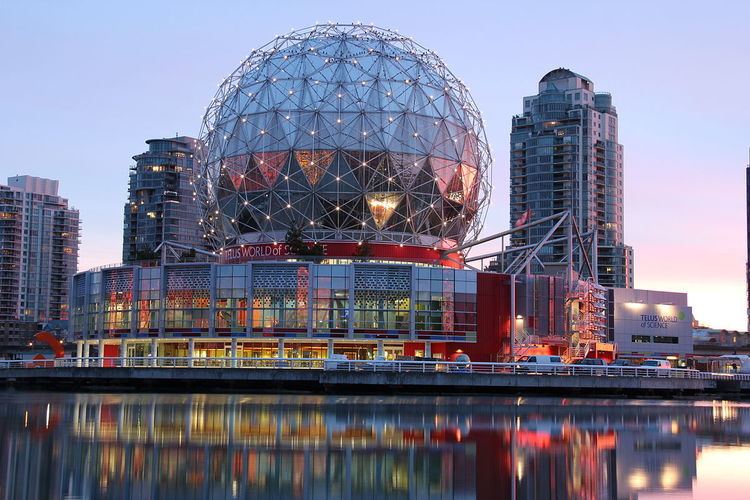Established 1977 Visitors 650,000 annually | Phone +1 604-443-7440 Founded 1977 | |
 | ||
CEO Scott D. Sampson (4 Jul 2016–) Similar Granville Island, Stanley Park, Capilano Suspension Bridge, False Creek, Canada Place Profiles | ||
Science World at Telus World of Science, Vancouver is a science centre run by a not-for-profit organization in Vancouver, British Columbia, Canada. It is located at the end of False Creek, and features many permanent interactive exhibits and displays, as well as areas with varying topics throughout the years.
Contents
The building's former name, Science World, is still the name of the organization. The building's name change to the Telus World of Science became official on July 20, 2005 following a $9-million donation to the museum from Telus. The official name of the science centre was subsequently changed to "Telus World of Science", although it is still routinely referred to as "Science World" by the public. Prior to the building being handed over to Science World by the City, it was referred to as Expo Centre during Expo 86. When Science World is operating in of the dome, it is referred to as Science World at Telus World of Science, and when it is out in the community it is simply Science World.
Science World Outreach
Science World runs a variety of outreach programs all over the province of British Columbia, including (until 2013) at their classroom in Aberdeen Centre in Richmond, BC, and in more remote locations such as Haida Gwaii and Ladysmith.
Their On the Road programmers travel throughout the province to conduct workshops and present science-themed shows in schools and communities that, otherwise, would not have access to a local science centre. As part of their Super Science Club program, Science World educators conduct after-school programs in designated inner-city schools to inspire at-risk children to become passionate about lifelong science and technology learning. Science World's Opening the Door program offers high-school students with an interest in science-based careers the opportunity to network with current science professionals.
History
In 1977, Barbara Brink ran mobile hands-on exhibits known as the Extended I around the Lower Mainland. Later, the temporary Arts, Sciences & Technology Centre opened in downtown Vancouver on January 15, 1982 attracting over 600,000 visitors. Another 400,000 benefited from the centre’s outreach programs, which were delivered around the province.
When Vancouver was awarded to host the transportation-themed 1986 World's Fair (Expo 86), a Buckminster Fuller-inspired geodesic dome was designed by Expo's chief architect Bruno Freschi to serve as the fair's Expo Centre. Construction began in 1984 and was completed by early 1985. After Expo closed its gates in October of that year, an intensive lobbying campaign was launched to secure the landmark building, relocate the "Arts, Sciences and Technology Centre" into the post-expo dome, and convert the Expo Centre into Science World. With much government backing, the dome was obtained from the province and a massive fund-raising campaign ensued. Donations from the federal, provincial and municipal governments, the GVRD, the private sector, foundations, and individuals contributed $19.1 million to build an addition to the Expo Centre, redesign the interior and fabricate exhibits. In 1988, in a four-month preview, over 310,000 visitors came to see the new building. A year later, The 400 seat OMNIMAX theatre in the upper section of the dome was opened, extending upon the 3D IMAX theatre which was built in 1986 for the Expo "Transitions" film series.
The centre entered its first title sponsorship agreement with Alcan Inc. in 1996, renaming its OMNIMAX Theatre the Alcan OMNIMAX Theatre. Alcan has since decided to sponsor the organization in different ways and the theatre has returned to its original name, the OMNIMAX Theatre. In January 2005, the building was officially renamed "Telusphere" as part of an agreement where Telus gave a $9-million donation in return for the naming rights of the building. This new name proved universally unpopular. In the summer of 2005, Telus and Science World officially changed the name of the building to the Telus World of Science. This maintained consistency with other "Telus World of Science" centres in Calgary and Edmonton that were named in the meantime. This name change has not affected the nearby SkyTrain station and the general public still refers to it as Science World.
During the 2010 Winter Olympics, Science World played host to Sochi World, a hospitality area representing the country of Russia, hosts of the 2014 Winter Olympics. The attraction closed in mid-January to facilitate the transformation, and was re-opened in March 2010.
Science World underwent renovation after the 2010 Winter Olympics. The indoor renovations completed as of mid-2012 and the adjacent Ken Spencer Science Park opened in late 2012.
Science World was briefly seen in the 2002 American telefilm First Shot.
